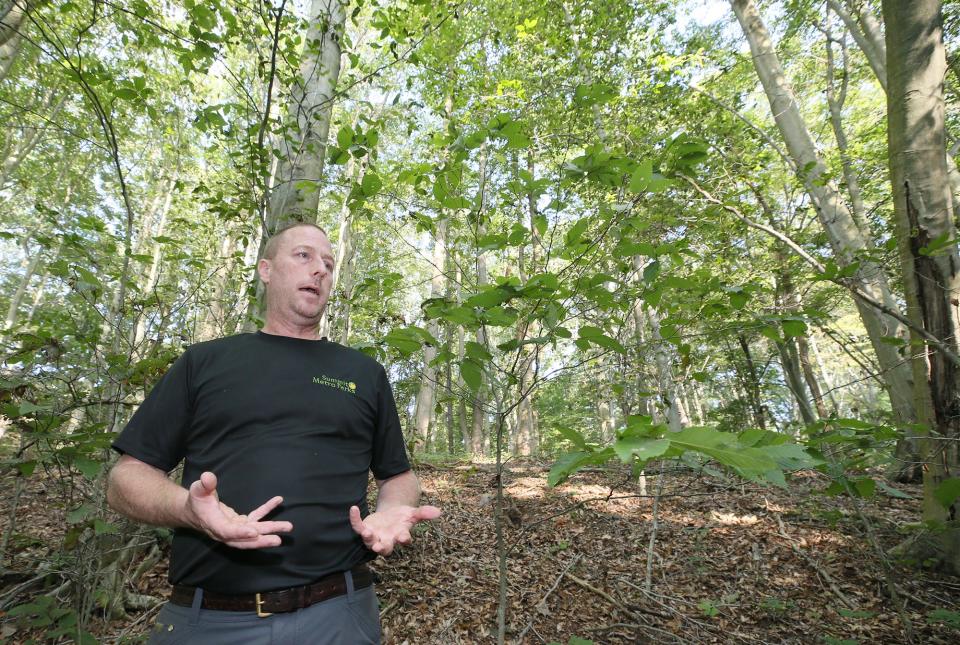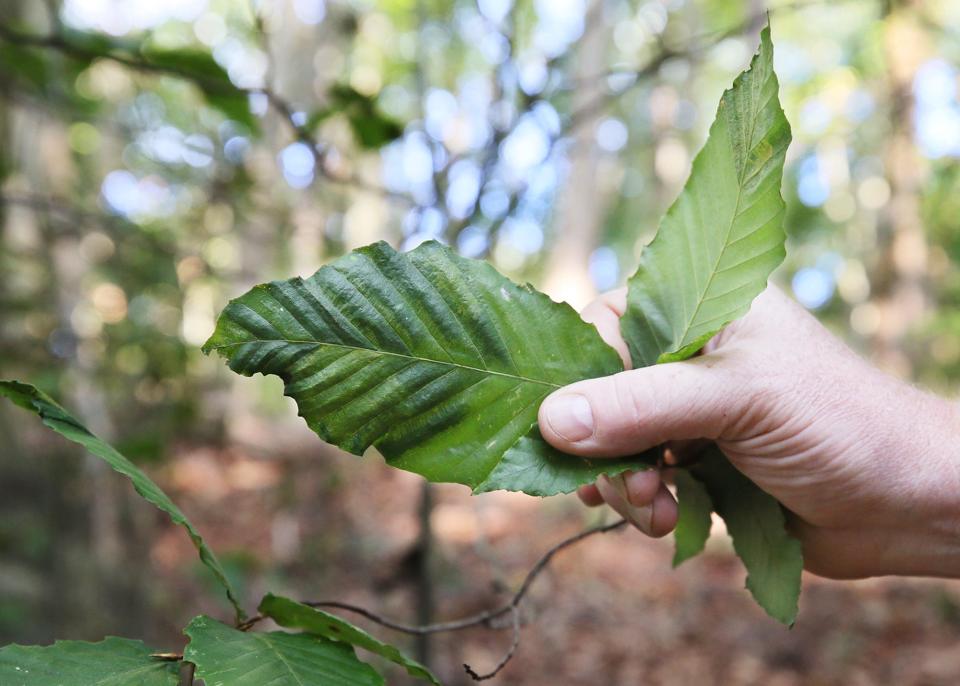What's going on with Ohio's beech trees? What you need to know about beech leaf disease
Fall in Northeast Ohio wouldn't be the same without the golden-yellow color of beech trees' oblong shaped leaves. But an invasive pest is imperiling the state's beech population, impacting saplings and seedlings the most, killing them within a few years and changing the ecology of the forests.

The beech tree — present in all 88 counties — plays an important role in Ohio's forests, serving as a food source and even a home for a vast array of wildlife. According to the Ohio Department of Natural Resources, beech leaf disease is present in at least a dozen counties in Northeast Ohio, including the Greater Akron area.
Since being discovered in Northeast Ohio in 2012, the disease has spread to 12 other U.S. states and Canadian provinces as well.
A microscopic, wormlike nematode damages the leaf tissue of beech trees, making them weak and vulnerable to disease, eventually killing them. Thousands of the nematodes infect the buds of the trees, wreaking havoc on foliage developing during winter. When the leaves unfold from the buds in springtime, the damage becomes apparent.
"We've just seen these beautiful, lush, important beech trees in our forest succumb to this devastating impact and mortality event," said Cleveland Metroparks' Senior Conservation Science Manager in Natural Resources Constance Hausman.
Trees infected with the blight can be spotted by the patterns on the leaves.

"Backlit by the sunshine,” said Hausman, “you can easily see these dark interveinal banding patterns." It's easily noticeable on smaller trees that are closer to eye level. They look leathery and chewed through.
History and spread
The disease was first detected in 2012 in Lake County, and in the Cleveland Metroparks system in 2014. In 2017, it was found in the Summit Metro Parks and the Medina County Park District.
As of last year, Medina County Park District found beech leaf disease on half of its properties. Cuyahoga Valley National Park is similarly affected.
It joins a series of landscape-changing blights that have hit Ohio's trees.
Dutch elm disease, chestnut blight and the emerald ash borer have all damaged the state's forests. The loss of forest diversity means that forests are less resilient in the face of invasive pests.
Rob Curtis, Summit County Metro Parks’ supervisor of ecological resources, said beach leaf disease is present throughout the park district, but it’s still in an early stage of progression. Between 6% and 10% of forest trees within lands managed by the Summit Metro Parks are American Beech.
Akron’s Park Maintenance Superintendent Jon Malish said the city doesn’t have many beech trees making up its canopy, which is comprised of 163 city parks and 55,000 street trees. As a result, beech leaf disease isn’t a major concern for Akron.
Hausman is unaware of a single unaffected beech in the Cleveland Metroparks.
All is not lost, however. Work is underway to find a way to combat beech leaf disease.
Searching for a treatment
Starting around 2017, the Davey Institute and Cleveland Metroparks teamed up to begin piloting treating infected beech trees with something called polyphosphite 30 — a potassium fertilizer — twice a year, applied in a way to avoid collateral damage to other species as much as possible.
Dan Herms, vice president of research and development at The Davey Tree Expert Company’s Davey Institute, said phosphites are known to activate plants’ natural defenses, though the mechanism by which this occurs isn’t thoroughly understood.
There's been a noticeable difference between untreated and treated trees since implementing the remedy, but treatment effects are minimal so far. Large-scale forest management strategies haven't been implemented.
"Within the first year to two years, we see significant retention of canopy cover on our treated trees," Hausman said. That means canopy cover with asymptomatic leaves or less severe symptoms and less die-back, with fewer nematodes present in the treated trees as quantified by the Davey Institute.
Cleveland Metroparks began working with Bartlett Tree Experts in 2019, and again in 2021, to investigate the viability of treating beech leaf disease with insecticides, much the same way that ash trees are treated against the emerald ash borer, another invasive species. Those applications don't initially appear as promising as the fertilizer application, but it's still early.
Treatment vs. natural selection
David Burke, vice president for science and conservation and lead beech leaf disease researcher at Holden Arboretum in Lake County, said treating infected trees in a forest setting is impractical because of how many there are.
Treatment is important for people with trees in their yard, or trees in a city park. The best approach is finding resistant trees and using them for reforestation, he said.
Summit Metro Parks is relying on the natural selection process. Treatment of trees isn’t a good long-term strategy but serves well to buy time to find other solutions, Curtis said.
“If we treat trees to kill the nematode, not only are we probably going to be killing a lot of native organisms, but we’re probably going to be thwarting the natural selective process because we’re going to be promoting a seed source and a pollen source of a tree that may be susceptible to disease,” Curtis said. “We ‘d rather the trees that are able to reproduce be the ones that are resistant to the disease and then produce offspring that are potentially resistant.”
Curtis said he doesn’t think that beech leaf disease will wipe out the beech population entirely. Without beech trees, the population of the nematode will bottom out. Eventually, a balance will form between the trees and the worm. He sees the natural selection process as the best way for the species to recover.
What's next?
The how and why of the spread of beech leaf disease is a puzzle that researchers are racing to find.
Last year, Holden Arboretum researchers found a new way to test for beech leaf disease.
Hausman said people can help by reporting instances of infected trees using an app called Tree Health Survey that was created jointly by Cleveland Metroparks and a professor and graduate students from Kent State University, with funding from the U.S. Forest Service.
There is a user manual for the app provided by Cleveland Metroparks on its website. The app can be found on Google Play or Apple's App Store.
Burke cautions people against simply cutting down their beech trees to try to prevent the disease from spreading. If it looks healthy, he said, it could be resistant. People made that mistake years ago, cutting down chestnut trees when chestnut blight appeared.
“The best approach is to sort of let nature take its course and assume there may be some resistance there,” Burke said.
Contact reporter Derek Kreider at DKreider@Gannett.com
This article originally appeared on Akron Beacon Journal: What's plaguing Ohio's beech trees? A look into beech leaf disease

